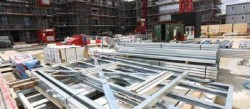As the UK Government strives to achieve its target of delivering 300,000 new homes a year, housebuilders are increasingly looking to new methods to speed up construction while also maintaining quality. While there is no single method or solution to address the need for quality residential housing, it is clear that new solutions must be considered in order to meet the Government's ambitious targets.
The benefits of offsite construction are well-documented yet the UK still lags behind other countries when it comes to adopting it as standard in housebuilding. So, what is holding housebuilders back and how can the use of light gauge steel framing speed up the build process?
As offsite construction is a relatively new concept, uncertainty, as well as unknown costs, remain major barriers. As there are currently not enough offsite housing projects completed to prove it is as a viable solution, the uptake of offsite construction remains comparatively slower within a housing development, a sector known to be firmly rooted in tradition and reluctant to embrace change. Another factor hindering the uptake of offsite construction in housing is the belief that it could be more expensive than traditional build methods. Considered the tried and tested formula, changing methods would mean introducing new systems and processes, something deemed unnecessary and too risky for many. The looming uncertainties of Brexit negotiations also play a role in the behaviour of housebuilders.
Possible material inflations and labour costs, as well as the fall in sterling, are reducing the value of potential earnings and proving to be key challenges for many housing developers. By working with steel manufacturers who can precision engineer light gauge steel profiles, housebuilders have the opportunity to prefabricate a housing shell in the factory and later assemble onsite, cutting out much of the material waste, time and installation costs associated with traditional build methods? Typically supplied as individual components and manufactured to meet specific sizing requirements or cut to length, light gauge steel profiles are screwed together onsite with self-drilling fixings to ensure absolute precision and accommodate tolerances in the structure's primary frame.
Thanks to the lightweight, high strength profiles, loads on both foundations and supporting structures can be minimised. Reducing the foundation load means a shallower foundation is required, saving initial site preparation time and costs. What's more, the performance of light gauge steel profiles is now better than ever before, yet with less steel required, enabling homes to be built faster without compromising on quality. The benefits of light gauge steel framing outweigh the barriers as decreased construction time on site, together with increased quality, can help to meet housing supply. Innovators must lead the way in adopting offsite construction if we are to see improvements in the numbers - and quality - of residential homes built.
The rollout of the new NHBC standards as of 1 January 2019 sees the first major update to Chapter 6.10 Light Steel Framing since it was first published in 2005, which is a massive step for off-site manufacturing. It is essential that the industry works together to ensure the same high standards are met across the board so the revisions in regulations to accommodate offsite procedures is a positive contribution towards achieving our shared goal of ensuring high standards. This will help to instil industry confidence and with time, we will see the increased uptake of offsite construction within the housebuilding business community. For more information visit: www.hadleygroup.com









